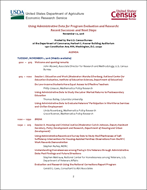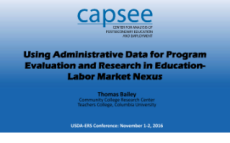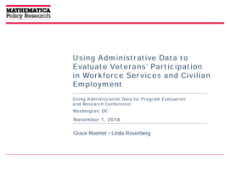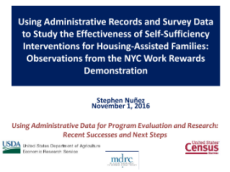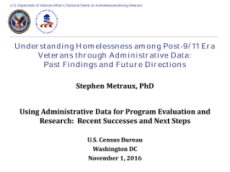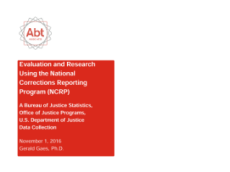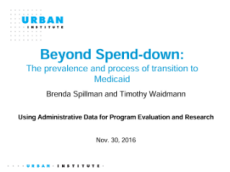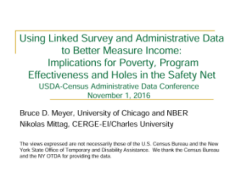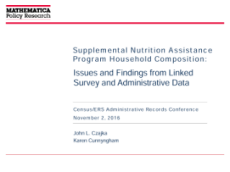Using Administrative Data for Program Evaluation and Research: Recent Successes and Next Steps
Using Administrative Data for Program Evaluation and Research: Recent Successes and Next Steps
Meeting Information
Dates and Times:
Tuesday, November 1, 2016 - 9:00 a.m. to 4:45 p.m.
Wednesday, November 2, 2016 - 8:30 a.m. to 12:00 p.m.
Location:
Department of Commerce
Herbert C. Hoover Building Auditorium
1401 Constitution Ave. NW
Washington, D.C. 20230
View on Webex:
Day 1 - censusevent.webex.com/censusevent/lsr.php?RCID=30d69e5095f8437fdd689607af4a83c8
Day 2 - census.webex.com/census/ldr.php?RCID=e0e45e9df58d1dd299d807b006e9e50d
Agenda
Welcome and opening remarks
John Abowd, Associate Director for Research and Methodology, U.S. Census Bureau
Session I. Education and Work
Moderator:
Marsha Silverberg, National Center for Education Evaluation, Institute of Education Sciences, Department of Education
Do Low-Income Students Have Equal Access to Effective Teachers
Presenter:
Philip Gleason, Mathematica Policy Research
Abstract:
Inequality in educational outcomes is substantial and persistent in the United States. Recent policy initiatives to address these gaps have emphasized teachers’ contributions to student achievement. A key question for policymakers is whether inequality in educational outcomes is caused by differences in students’ access to effective teachers. This report examines whether low-income students are taught by less effective teachers than high-income students, and if so, whether reducing this inequity would close the student achievement gap. We also describe how the hiring of teachers and their subsequent movement into and out of schools could affect low-income students’ access to effective teachers. To address these questions, we obtained administrative data covering 4th to 8th grade students and teachers from 26 school districts around the country over a five-year period, from the 2008-2009 to 2012-2013 school years. The data include students’ scores on state assessments, students’ demographic and other characteristics, links between students’ and their English/Language Arts and math teachers, and teacher characteristics. With these data, we estimated value-added models to measure teacher effectiveness, compared the effectiveness of teachers of high- and low-income students (using students’ free and reduced-price meal status to measure income level), and examined teachers’ movement into, between, and out of high- and low-poverty district schools.
Using Administrative Data to Study the Labor Market Returns to Postsecondary Education
Presenter:
Thomas Bailey, Columbia University
Abstract:
This presentation will draw on research conducted by researchers at the Center for the Analysis of Postsecondary Education and Employment (CAPSEE), headquartered at Teachers College, Columbia University. CAPSEE is funded by the Institute for Education Sciences at the Department of Education. CAPSEE researchers have used detailed college transcript data linked to unemployment insurance data from eight states to analyze the labor market returns to postsecondary education. The presentation will review the most important outcomes and insights from the Center's research, discuss the strengths and weaknesses of using these data for this type of analysis, and make some suggestions about changes that could improve the efficiency of the process of acquiring and analyzing administrative data for this purpose.
Using Administrative Data to Evaluate Veterans’ Participation in Workforce Services and Civilian Employment
Presenters:
Linda Rosenberg, Mathematica Policy Research
Grace Roemer, Mathematica Policy Research
Abstract:
This presentation will describe how Mathematica Policy Research (Mathematica) used administrative data to evaluate veterans’ participation in workforce services and civilian employment as part of two recent studies for the U.S. Department of Labor (DOL).
On the Veterans’ Supplemental Study, as part of the Workforce Investment Act (WIA) Adult and Dislocated Worker Programs Gold Standard Evaluation, Mathematica analyzed veterans’ participation in workforce services in two states using a data base that combined data from Wagner-Peyser/Employment Services and WIA—DOL’s two major public workforce programs. On the Evaluation of the Army Unemployment Compensation for Ex-service Members Claimants’ Initiative, Mathematica analyzed veterans’ post-separation employment and workforce services experiences in one state; to complete these analyses, Mathematica used data from five separate state data bases linked with data from the Army.
This presentation will cover:
- The specific research goals of each study and high level findings;
- How each study team identified and obtained administrative data to address research questions that required multiple data sources; and
- Lessons learned about the use of administrative data to analyze veterans’ participation in workforce services and civilian employment.
Session II. Housing and Criminal Justice
Moderator:
Calvin Johnson, Deputy Assistant Secretary, Policy Development and Research, Department of Housing and Urban Development
Using Administrative Records and Survey Data to Study the Effectiveness of Self-Sufficiency Interventions for Housing-Assisted Families: Observations from the NYC Work Rewards Demonstration
Presenter:
Stephen Nuñez, MDRC
Abstract:
In 2007, New York City officials launched three initiatives testing distinct strategies for promoting employment and economic well-being among housing-assisted recipients, particularly those receiving Housing Choice Vouchers, which provide rent subsidies. Called the Work Rewards demonstration, the collection of interventions tested the effectiveness of New York City’s Family Self-Sufficiency (FSS) program alone, FSS combined with a set of special work incentives, or “reward payments, and a separate test of the special incentives by themselves.” These interventions targeted voucher holders with household income under 130 percent of the federal poverty level.
Using randomized control trials, Work Rewards assessed the effects of the FSS program and special work incentives on employment and other quality-of-life outcomes among nonelderly and nondisabled voucher holders. FSS and FSS + the special work incentives were tested in partnership with New York City Department of Housing Preservation and Development (HPD); the special work incentives offered alone were tested in partnership with the New York City Housing Authority (NYCHA).
The evaluation drew on extensive qualitative and quantitative data to report on participant experiences, program impacts, and program benefit-costs. This includes six years of administrative records on employment, earnings obtained from New York State unemployment insurance (UI) wage records; welfare and food stamp payments obtained from the New York City Human Resources Administration, and housing subsidy data obtained from the two PHAs participating in the demonstrations; FSS services and milestones from a MIS used by the program operators; FSS graduation and escrow outcomes from the PHA operating the FSS program (HPD); data from an 45-minute in-depth survey completed with FSS study participants about 42 months after they enrolled in the program; qualitative data obtained through in-depth interviews with a sample of FSS participants and nonparticipants and through observations of program operators selected to implement Work Rewards; and program operation costs.
This presentation reports on findings from this long-term evaluation and describes the uses of the abovementioned data sources to support a comprehensive research agenda, assessing the implementation and effectiveness of employment-focused interventions for housing-assisted families. The presentation will also reference the use of these types of data and methodologies in other national evaluations of interventions for voucher households.
Understanding Homelessness among Post-9/11 Era Veterans through Administrative Data: Past Findings and Future Directions
Presenter:
Stephen Metraux, National Center for Homelessness among Veterans, U.S. Department of Veterans Affairs
Abstract:
This presentation reviews several studies conducted by the author and his colleagues that focus on the nature and extent of homelessness among veterans from the current era, which includes those veterans who were deployed in Iraq and Afghanistan. The focus here is on the capabilities and challenges of investigating this topic in a data-rich environment, and how the administrative data sources used in these studies can inform a homelessness prevention initiative.
Evaluation and Research Using the National Corrections Report Program
Presenter:
Gerald G. Gaes, Consultant to Abt Associates
Abstract:
The National Corrections Reporting Program (NCRP) is a Bureau of Justice Statistics (BJS) data collection program, which collects offender-level data on persons admitted to and released from state prisons and post-confinement community supervision. BJS obtains administrative records from state departments of corrections and community supervision in all fifty states. Offender records include unique offender identification numbers, demographic information (e.g., age, sex, race, education level, veteran status), conviction offenses, sentence length, minimum time to be served, type of admission, and type of release. The unique offender identifiers enable BJS to link individual offender prison terms, as well as potentially to link NCRP records to offender records in other federal administrative databases.
Since 1983, BJS has used the NCRP to monitor correctional populations and address policy questions related to recidivism, prisoner reentry, and trends in demographic characteristics of the incarcerated and paroled populations. More recently, BJS has begun exploring whether the NCRP can be used to evaluate policy initiatives. This presentation highlights analyses undertaken by BJS and its data collection agent (Abt Associates) that have focused on:
- Alternative definitions of recidivism that have different policy implications
- The effects of welfare benefits on offender recidivism
- The impact of the Affordable Care Act on offender recidivism
- The effects of the Justice Reinvestment Initiative reforms on prison admissions, total prison populations, and prison population offender seriousness levels
Session III. Health and Income Security
Moderator:
Mary Bohman, Administrator, Economic Research Service
Beyond Spend-down: The Prevalence and Process of Transitions to Medicaid
Presenter:
Brenda Spillman, The Urban Institute
Abstract:
Aged Medicare beneficiaries are disproportionately expensive for Medicaid because of their high likelihood of using long term services and supports. Nursing home costs still dominate Medicaid spending for the aged. This study updates and expands knowledge about the prevalence and process of transitions to Medicaid among aged Medicare enrollees, with a focus on the role of nursing home use, using multiple years of Medicare, Medicaid, and assessment data linked to the 2004 National Long Term Care Survey (NLTCS).
SNAP Benefits and Pregnancy-Related ER Visits
Presenter:
Irma Arteaga, University of Missouri
Abstract:
Income constraints at the end of the month may limit food consumption and trigger health problems for low-income individuals with health conditions making them sensitive to daily fluctuations in nutritional in-take. We examine how the date that benefits are issued for the Supplemental Nutrition Assistance Program (SNAP) changes the probability that a pregnant woman will go to the emergency room. We use linked administrative data from SNAP and Medicaid for the state of Missouri over the 2008-2010 time period for more than 2.7 million claims. Missouri was the only state in the nation to issue SNAP benefits over a 22-day period during the calendar month; payment date was based on the first letter of the household head’s last name and month of birth, providing an exogenous source of variation to the timing of benefit receipt. Women who received SNAP benefits in the second or third week of the calendar month were less likely to submit a pregnancy-related ER claim in the following week than they were earlier in the month. Additionally, we found that women who receive higher levels of SNAP benefits were less likely to submit an ER claim than those with lower levels. Results from this study offer strong empirical evidence about the health benefits of SNAP participation. The study also speaks to the importance of programmatic decisions, such as the timing of the issuance of program benefits, which may have significant consequences for recipients.
Using Linked Survey and Administrative Data to Better Measure Income: Implications for Poverty, Program Effectiveness and Holes in the Safety Net
Presenters:
Bruce Meyer, University of Chicago
Nikolas Mittag, CERGE-EI/Charles University
Abstract:
We examine the consequences of underreporting of transfer programs in household survey data for several prototypical analyses of low-income populations. We focus on the Current Population Survey (CPS), the source of official poverty and inequality statistics, but provide evidence that our qualitative conclusions are likely to apply to other surveys. We link administrative data for food stamps, TANF, General Assistance, and subsidized housing from New York State to the CPS at the household level. Program receipt in the CPS is missed for over one-third of housing assistance recipients, 40 percent of food stamp recipients and 60 percent of TANF and General Assistance recipients. Dollars of benefits are also undercounted for reporting recipients, particularly for TANF, General Assistance and housing assistance. We find that the survey data sharply understate the income of poor households, as conjectured in past work by one of the authors. Underreporting in the survey data also greatly understates the effects of anti-poverty programs and changes our understanding of program targeting, often making it seem that welfare programs are less targeted to both the very poorest and middle income households than they are. Using the combined data rather than survey data alone, the poverty reducing effect of all programs together is nearly doubled while the effect of housing assistance is tripled. We also re-examine the coverage of the safety net, specifically the share of people without work or program receipt. Using the administrative measures of program receipt rather than the survey ones often reduces the share of single mothers falling through the safety net by one-half or more.
Session IV. Data and Modeling Issues
Moderator:
Bob Dalrymple, Food and Nutrition Service
Joint Project between the U.S. Census Bureau, the Food and Nutrition Service, and the Economic Research Service
Presenter:
Mark Prell, Economic Research Service
Abstract:
The Census-FNS-ERS joint project is a strategic partnership that is acquiring USDA administrative data from States and linking those data to the American Community Survey and other surveys, which leverages the strengths of each data source and each partner. This presentation explains how the partnership addressed some common barriers to projects that use administrative and linked data, explores data and modeling issues, and summarizes selected research results. As USDA agencies, ERS and FNS seek to inform policymakers and others on: who participates in USDA food assistance programs, how program participation affects the lives of those individuals, and who does not participate and why. The Census Bureau’s interests are primarily to improve their surveys, the 2020 Census, and data-linkage processes. The joint project serves the missions of all three agencies, gaining policy-relevant results using linked data that are unobtainable using either data source separately. Three recent products are ERS reports on the Supplemental Nutrition Assistance Program (SNAP) that examined sub-State detail on SNAP access, targeting of SNAP benefits by income level, and measurement of monthly and annual SNAP participation rates.
Supplemental Nutrition Assistance Program Household Composition: Issues and Findings from Linked Survey and Administrative Data
Presenters:
John Czajka, Mathematica Policy Research
Karen Cunnyngham, Mathematica Policy Research
Abstract:
When a household survey is used to simulate eligibility for the Supplemental Nutrition Assistance Program (SNAP), a key step is to identify the SNAP unit(s) within each sample household. A SNAP unit is defined as those individuals who share a residential unit and customarily purchase and prepare food together. Individuals who live together but do not purchase and prepare food together generally may apply as separate SNAP units. Typically, household surveys that collect data on SNAP participation do not identify the members of the SNAP unit. Thus, eligibility simulations must construct SNAP units. Comparisons of aggregate characteristics between SNAP units in administrative data and simulated eligible SNAP units in survey households show large differences. Most notably, eligibility simulations generate too few one-person units. Because administrative data are compiled at the unit level rather than the household level, it is not clear if the shortfall in one-person units is due to underestimating the frequency of multiple units within households or across households. This paper presents findings from an analysis of linked data from three Census Bureau surveys and SNAP administrative records from two states. SNAP unit membership as recorded in the administrative data was compared to simulated unit membership from two surveys (the American Community Survey and the Current Population Survey Annual Social and Economic Supplement) and reported unit membership from the third (the Survey of Income and Program Participation). Our results suggest that the underestimation of one-person units is due to too few households with simulated eligible one-person units rather than too few households with multiple simulated one-person units. Other key findings include the frequency with which SNAP households include persons who are not in a SNAP unit—that is, not receiving SNAP benefits. The paper includes a discussion of issues in linking SNAP administrative records to household survey data and how limitations in both data sources may affect empirical outcomes.
Panel Discussion. Policymaker Perspectives on Administrative Data and Program Evaluation and Research
Moderator:
Robin Bachman, Chief, Policy Coordination Office, U.S. Census Bureau
Discussants:
Calvin Johnson, Deputy Assistant Secretary, Policy Development and Research, Office of Research, Evaluation and Monitoring, Department of Housing and Urban Development
Susan D. Sullivan, Deputy Assistant Secretary for Data Governance & Analytics, Office of Policy and Planning, Department of Veterans Affairs
Richard Lucas, Deputy Administrator for Policy Support, Food and Nutrition Service, U.S. Department of Agriculture
Mark Fucello, Division Director, Division of Economic Independence, Administration for Children and Families
Marsha Silverberg, Economist and Team Leader, National Center for Education Evaluation, Institute of Education Sciences, Department of Education
Meeting Materials
Photo

Dr. Thomas Bailey of Columbia University
